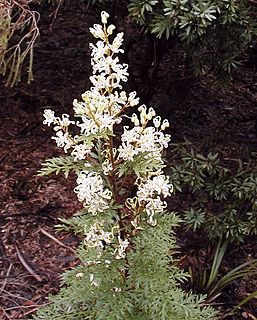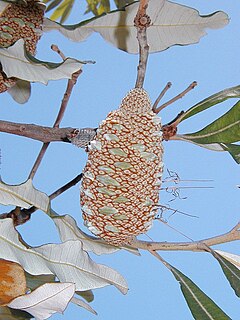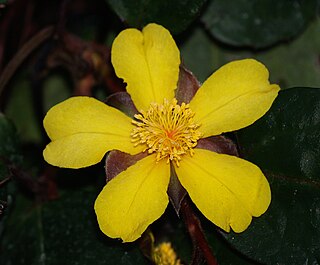
Curtisia dentata is a flowering tree from Southern Africa. It is the sole species in genus Curtisia, which was originally classed as a type of "dogwood" (Cornaceae), but is now placed in its own unique family Curtisiaceae.

An assegai or assagai is a pole weapon used for throwing, usually a light spear or javelin made up of a wooden handle and an iron tip.

Lomatia is a genus of 12 species of evergreen flowering plants in the protea family Proteaceae. Within the family, they have been placed, alone, in their own subtribe, Lomatiinae according to Johnson & Briggs 1975 classification of the family and subsequently in Flora of Australia (1995).
Mitchell Wilson Lichtenstein is an American actor, writer, producer and director.

The Asian leaf turtle is a species of turtle found in Southeast Asia. They are quite common in the pet trade; their carapaces resemble that of a Cuora amboinensis hybrid.

Quercus dentata, also called Japanese emperor oak or daimyo oak is a species of oak native to East Asia. The name of the tree is often translated as "sweet oak" in English to distinguish it from Western varieties.

Banksia dentata, commonly known as the tropical banksia, is a species of tree in the genus Banksia. It occurs across northern Australia, southern New Guinea and the Aru Islands. Growing as a gnarled tree to 7 m (23 ft) high, it has large green leaves up to 22 cm (8.7 in) long with dentate (toothed) margins. The cylindrical yellow inflorescences, up to 13 cm (5.1 in) high, appear over the cooler months, attracting various species of honeyeaters, sunbirds, the sugar glider and a variety of insects. Flowers fall off the ageing spikes, which swell and develop follicles containing up to two viable seeds each.

Hibbertia dentata, commonly known as toothed guinea flower, trailing guinea flower or twining guinea flower, is an ornamental plant in the family Dilleniaceae native to the east coast of Australia. Found in woodland, it is a trailing or twining vine with leaves with several small 'teeth' on the margins and bright yellow flowers in early spring. It adapts readily to cultivation and can be grown as a pot plant. The species was first described in 1817.
The Field Elm cultivar Ulmus minor 'Albo-Dentata' first featured in the Baudriller nursery catalogue of 1880 as U. microphylla foliis albo-dentata. It was distributed by the Späth nursery of Berlin in the late 19th and early 20th century, as U. campestris microphylla fol. albo-dentatis.

The Sahel bush sparrow or bush petronia, is a species of bird in the family Passeridae. It is found in Africa from Mauritania to Guinea and east to Eritrea and the south-western Arabian Peninsula in its natural habitats of dry savanna and subtropical or tropical dry shrubland.

Cyclemys is a genus of freshwater turtles, commonly referred to as Asian leaf turtles, from the family Geoemydidae. The genus occurs throughout Southeast and South Asia, and currently contains seven species.

The fascia dentata is the earliest stage of the hippocampal circuit. Its primary input is the perforant path from the superficial layers of entorhinal cortex. Its principal neurons are tiny granule cells which give rise to unmyelinated axons called the mossy fibers which project to the hilus and CA3. The fascia dentata of the rat contains approximately 1,000,000 granule cells. It receives feedback connections from mossy cells in the hilus at distant levels in the septal and temporal directions. The fascia dentata and the hilus together make up the dentate gyrus. As with all regions of the hippocampus, the dentate gyrus also receives GABAergic and cholinergic input from the medial septum and the diagonal band of Broca.
Ologamasidae is a family of mites in the order Mesostigmata.
Athiasella is a genus of mites in the family Ologamasidae.
Athiasella coniuncta is a species of mite in the family Ologamasidae.
Athiasella markmitchelli is a species of mite in the family Ologamasidae.
Athiasella sellaris is a species of mite in the family Ologamasidae.
Athiasella stefani is a species of mite in the family Ologamasidae.
Athiasella tuberculata is a species of mite in the family Ologamasidae.

Lomatia dentata, commonly known as piñol or avellanillo, is a species of tree in the family Proteaceae.










